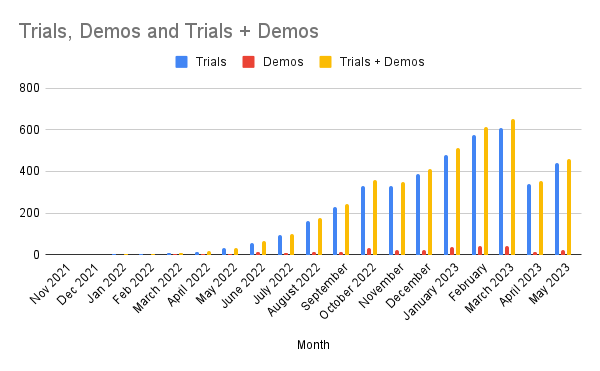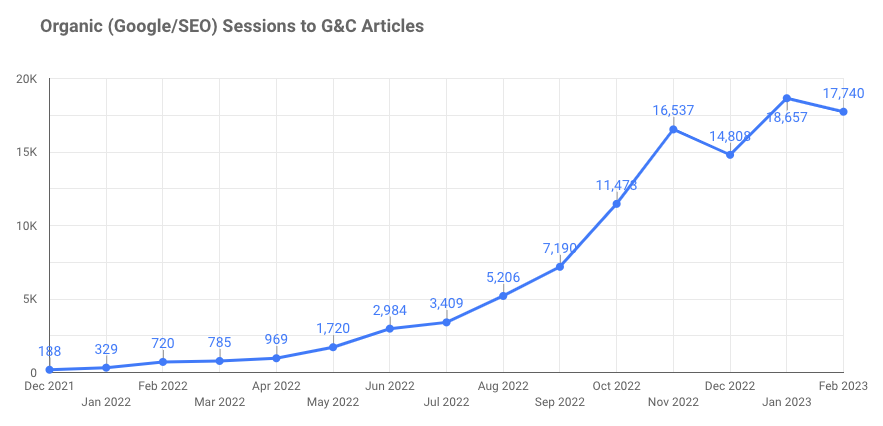Smartlook is a product analytics and visual user insights platform based in the Czech Republic that was recently acquired by Cisco.
When they hired us for our SEO and content marketing services in the fall of 2021, they had limited brand recognition in the US, especially as compared to top competitors Hotjar and FullStory. One of Smartlook’s key marketing objectives was expanding their U.S. customer base by ranking for valuable keywords in the web and product analytics space.
In addition, Smartlook also wanted to bring more exposure to their product analytics features in order to attract more advanced users. While they were best known for their heatmap and session recording tools, their customer retention data indicated that customers who used their more advanced product analytics features — event tracking, funnel analysis, retention tables, crash reports, cross-platform analytics, etc. — got more value out of the tool and stuck around longer. So they wanted to build their authority as a product analytics tool, and not just a web analytics tool, to attract users who were more likely to need these additional features.
Here’s how we used SEO, specifically our Pain Point SEO process, to help with these challenges.
SEO Is Ideally Suited to Attract Specific Customer Personas
Unlike paid display, paid social, or even most paid search campaigns, long form SEO content is an ideal channel for B2B SaaS companies looking to attract users looking for very specific features, because it allows you to target people who are searching for extremely specific things exactly when they’re interested.
In contrast, while social and display ads offer some ability to target the right people, they have almost no ability to capture their interest at the right time — when they’re looking for a solution to the problem. Instead, they just show up when people are browsing the web or social media for any reason. High-quality content that targets long tail buying keywords, on the other hand, lets you show up for the exact search queries that indicate the user has pain points that map to your features and rank for those features.
Paid search (or PPC) can also be difficult to apply to specific, long tail queries. In particular, we’ve noticed that many of these queries don’t have enough search volume for Google to decide to show ads for (we’ve tested this), but if you rank for these terms organically you can get enough search traffic and leads to make a real difference (as our results below show).
Finally, long form content gives you the right medium — specifically, enough space — to explain advanced features and demonstrate how they help your target audience solve specific pain points. This space also lets you include the amount of copy necessary to adequately fulfill search intent and rank for competitive keywords.
For these reasons, we were excited to help Smartlook via our content process.
Applying Our SaaS SEO Strategy to Find and Rank for High Intent Keywords
When we started working with Smartlook, we immediately noticed a pattern in their existing content. Their blog had a lot of well-written educational articles about high-level topics related to website analytics and product analytics, but their only content aimed at high intent keywords were landing pages and feature pages.
For example, they had several landing pages that targeted competitor-type keywords like “Hotjar Alternative” and “FullStory Alternative.” The landing pages were well designed from a conversion-rate optimization (CRO) standpoint and included compelling copy about Smartlook’s features. Similarly, their standard feature pages had a sharp design, strong visuals, and interactive features.
But almost none of these landing pages and feature pages were ranking on the first page of Google. Most weren’t even ranking in the top 100 results. Why not? In both types of pages, the total word count per page was less than 500. It’s a common problem with landing pages: the content was too thin compared to the content existing on the search engine results page (SERP), and it lacked both key elements searchers were looking for and the crucial on-page SEO elements search engines look for.
The competitor alternative landing pages didn’t include a thorough analysis of how those features compared to the competitor, nor any insight into what the shortcomings of the competitor products might be. And the feature pages didn’t have enough space to really dig into the use cases of each feature with examples that would resonate with readers.
These two factors — too little content and not meeting search intent — were the key reasons these pages weren’t ranking (and are very common reasons most SEO agencies struggle to generate rankings and conversions).
Content for High Buying-Intent Keywords
To address this, we applied our SaaS content marketing strategy and found dozens of long tail competitor and category keywords with high buying-intent that Smartlook didn’t rank for.
When we analyzed the SERP for each keyword, we determined that searchers would be best served by an in-depth blog post, instead of a landing page, because it would give us the space to dig into the nuances of the differences between Smartlook’s features and their competitors, while showcasing Smartlook’s deep knowledge and expertise in the product analytics space.
We combined our SEO strategy with our intelligent, thoughtful writing that demonstrates how a product or service solves the customer’s problem (we call it Pain Point Copywriting) to produce new content that offered the in-depth analysis searchers were looking for and presented a compelling pitch for Smartlook’s solutions.
Compare the user experience of their landing page, Hotjar Alternative, with our blog post, 12 Hotjar alternatives for website and mobile app analytics:


The reader can immediately see that the blog post will help them make an informed decision — especially if they have a very specific use case in mind and want to make sure the tool they choose is appropriate.
While the landing page includes social proof in the form of testimonials and G2 ratings as well as screenshots of their key features with the value proposition of each one in clear, compelling copy, there’s no analysis of how these features compare to Hotjar, which is likely to be a high priority for the person searching “Hotjar alternatives.”
Content for Mid-Funnel Keywords
Our keyword research also turned up several jobs-to-be-done keywords (JTBD), which are descriptions of the use case for a feature that don’t include the name of the feature or the product category. This area of keyword research can often be a gold mine for SaaS companies.
Searchers who choose to describe the problem they’re trying to solve are often advanced users looking for validation that a product can solve that exact problem. In many cases, they’ve already tried a product in the category that didn’t meet their needs, so they’re refining their Google search to turn up new products that can meet their exact use case. In this way, even though JTBD keywords are higher up in the funnel than the keywords discussed above, they still have product buying-intent. But unlike some of the more obvious buying-related keywords, JTBD keywords often require very few backlinks to rank.
For example, the phrase “tracking user activity on website” is a long tail keyword we targeted early on in the engagement. It’s a more precise search query than phrases like “session recording tool” or “website analytics.” After evaluating the SERP, we determined that searchers were looking for tools that could help them track specific user interactions like button clicks and text inputs and provide insights into why users behaved the way they did. This keyword was a great fit for Smartlook because it allowed us to highlight their advanced features for an audience that was clearly looking for those features.
Many SEO agencies won’t go after these keywords because they have low monthly traffic on Ahrefs. But we know that Ahrefs and other tools grossly underestimate the volume of long tail keywords, and this keyword was no exception. While Ahrefs estimated the traffic for the phrase “tracking user activity on website” at 40 searches per month, it accumulated nearly 7,000 organic sessions in the final nine months of our engagement (20 times more than Ahrefs’ volume estimate would have predicted). Across all of our content, that piece was one of our top 10 performers by conversion volume.
Lastly, in keeping with our proven SEO tactic of creating separate blog posts for each target keyword, we also did a lot of “vs” pieces and “alternatives” pieces, offering head-to-head comparisons between Smartlook and a wide variety of competitors, including products that were more familiar to the advanced users Smartlook wanted to attract, such as Amplitude and Mixpanel.
These three types of keywords (category, competitors and alternatives, and jobs to be done) accounted for every piece within our top 15 converting pieces.

Results: 600+ Monthly Conversions, 37 Top 10 Rankings, and Traffic Growth
This engagement produced some of the most impressive results we’ve seen.
As we do with all of our clients, we created a custom dashboard in Google Analytics to track conversion metrics from our content. In this case, we tracked free account sign-ups and demo requests.
We grew conversions to our content to more than 600 per month in 16 months.

By creating dedicated high-quality blog posts for each high intent keyword we identified, we helped Smartlook gain dozens of top three organic search rankings in Google in the U.S., growing their brand awareness and customer base.
Of the 50 keywords we targeted during the engagement, we had the following wins:
- 11 no. 1 rankings
- 20 top 3 rankings
- 37 top 10 rankings
- Average position of 7

We also helped them meet aggressive goals for organic traffic growth during the engagement. Organic traffic to our posts alone grew to 18,000+ per month.

It was a pleasure to work with Smartlook’s marketing team as well as nearly a dozen subject matter experts generously lent their time to thoroughly explain the ins and outs of their product and the problems it solves for their customers.
And, while we don’t take credit for Cisco noticing the good work the Smartlook team has been doing, we were pleased to see that one of the key reasons Cisco highlighted for the acquisition was how Smartlook helps users “troubleshoot hard-to-replicate digital behavior anomalies and analyze user interaction trends across web and mobile application platforms.” Those are some of the key benefits we focused on in our content, and it’s nice to see that message resonating with a worldwide technology leader.
More Grow and Convert Case Studies
Here are five other case studies, each with unique insights, that you can read to see how we’ve executed our SEO strategy for other B2B and SaaS businesses:
How to Work with Us or Learn More
- Our Agency: If you want to hire us to execute a content-focused SEO strategy, complete with content creation, link building, and technical SEO, learn more about working with us here.
- Join Our Team: If you’re a content marketer or writer and would love to do content marketing in this way, we’d love to have you apply to join our team.
- Our Content Marketing Course: Individuals looking to learn our agency’s content strategy and become better marketers, consultants, or business owners can join our private course and community, taught via case studies, and presented in both written and video content formats. We include several details and examples not found on this blog. Our course is also built into a community, so people ask questions, start discussions, and share their work in the lesson pages themselves, and we, along with other members, give feedback. Learn more here.





















